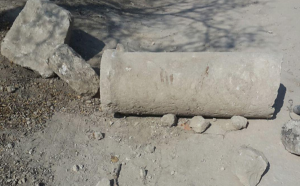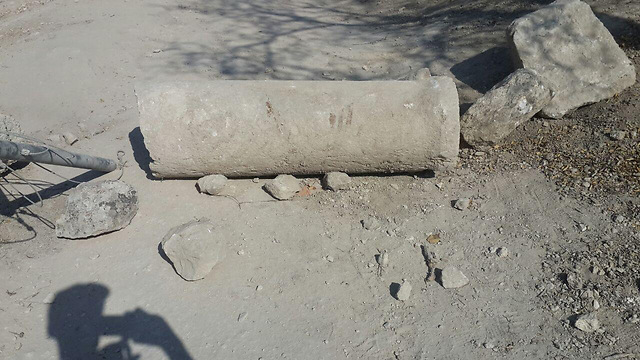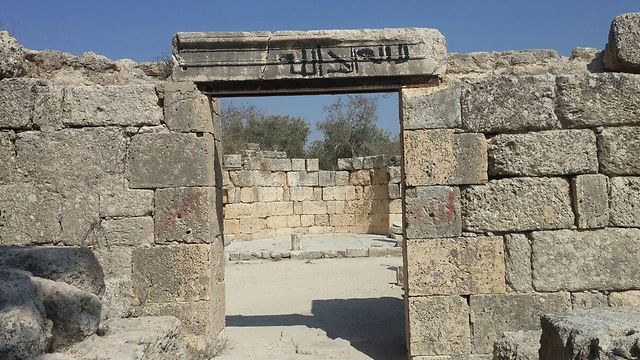
The Samaria National Park (Sebastia), site of the capital of Israel for 150 years, was found with Roman columns broken and turned into roadblocks, uprooted seats in the amphitheater and Arabic graffiti sprayed on many ancient stones.
By Assaf Kama
The Samaria National Park (Sebastia), some 10 kilometers north of Nablus, was found to have been vandalized with graffiti in Arabic, an ancient marble column toppled, a smashed tombstone and the remains of burnt tires discovered. The Samaria visiting and learning center organized a tour of the site for journalists to show the site’s degradation.

Photo: Assaf Kamar
The Samaria Regional Council protested that a Palestinian flag had been hoisted inside the park. The council’s chairman, Yossi Dagan, commented, “This is abandonment of historical and archaeological treasures that are thousands of years old.”
The site contains artifacts of national importance from biblical times and the early Christian period. At the site, which researchers have labeled as the historical palace of the House of Omri—the celebrated Israelite dynasty—unknown persons have poured a concrete base decorated with used stun grenades and erected an iron pole with a Palestinian flag therein. Pressured by settlers in Samaria, the IDF removed the flag and pole earlier in the week. Other Palestinian flags were hung in the nearby trees.

Ancient marble columns toppled by Palestinian vandals: Assaf Kamar
A Roman marble column from the time of Caesar Augustus was dragged from its place and used to block a pedestrian access road to the site.
At the Byzantine church, where medieval tradition holds that the head of John the Baptist is interred, Arabic graffiti was painted on pillars and walls. An ancient Christian tombstone elsewhere at the site was smashed.

Photo: Assaf Kamar
At the Roman amphitheater, which had been heretofore well-preserved, stone seats were upended and illegal digging was carried out, ostensibly to steal artifacts.
Prof. Avraham Faust, an archaeologist of the Martin (Szusz) Department of Land of Israel Studies and Archaeology at Bar Ilan University, commented, “(My) heart hurts; this is very sad. We have to maintain the site. This is a city with Jewish and Christian cultural value that is connected to the entire world. The site is not scientifically controversial. It was a magnificent city that served as the capital of Israel for 150 years, from the city’s foundation by the Israelite King Omri until its destruction by the Assyrian kingdom, and it is even mentioned in Assyrian writings.”

Photo: Assaf Kamar
The huge archaeological site is located in Area C, which is under complete Israeli control, but its parking lot and access road are in Area B, the civilian control of which is under Palestinian purview.
View original Arutz Sheva publication at:
http://www.ynetnews.com/articles/0,7340,L-4849755,00.html






 Israeli New Shekel Exchange Rate
Israeli New Shekel Exchange Rate